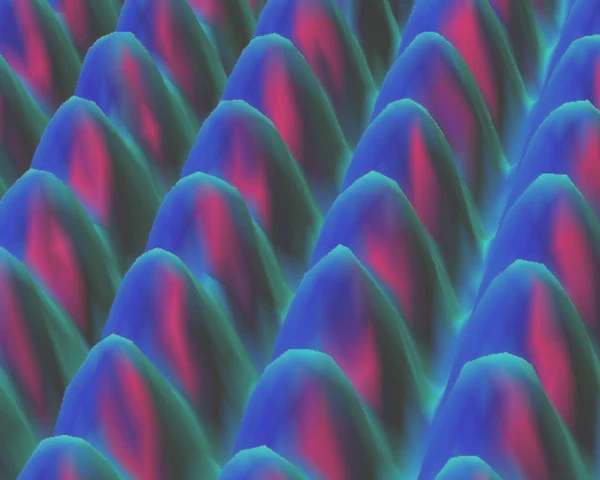
Image description: Since the 1990s, thanks to the Scanning Tunneling Microscope, it has been possible to see and manipulate individual atoms on the surface of a material. To create this type of image, the microscope's very fine tip scans the surface of the material, a few nanometers above it, emitting a constant electrical voltage. By passing over the atomic orbitals, it is capable of recording tiny variations in the tunneling current that flows on the surface. On the surface of the material, only a small flux of electrons manages to cross the potential barrier by the tunnel effect, a well-known phenomenon in quantum mechanics. This electric current is then measured by the microscope, which faithfully reproduces the topography of the surface, with a resolution of about 0.1 nanometers or 1 angstrom, i.e., the size of the atom. Image credit: STM Image Gallery Blue Nickel.
The atom is the smallest particle of a chemical element; it consists of a nucleus around which a certain number of electrons move, 1 for hydrogen, 6 for carbon, 26 for iron, 92 for uranium, etc.
It is the electron-electron interactions due to their astonishing quantum properties that give rise to the great diversity of elements found in nature. The organization of the elements of nature is represented by the periodic table of elements or Mendeleev's table, which classifies all natural and artificial chemical elements, ordered by increasing atomic number (number of protons) and organized according to their electronic configuration.
The world of electrons belongs to the quantum world of atoms, i.e., the microscopic world. In 1 gram of matter such as carbon 12, there are ≈1022 atoms. The approximate size of atoms has been known since 1811. Amedeo Avogadro (1776-1856) estimated this size to be 1 angstrom, i.e., 10-10 meters, and a century later, in 1911, Ernest Rutherford (1871-1937) specified the structure of the atom and gave a size to the atomic nucleus of about 10-14 meters. It can be said that atoms are separated from each other by a few angstroms.
Since the advent of quantum mechanics in the 1920s, the electron is no longer represented as an object orbiting regularly around the nucleus. We know today that the movement of an electron is very different from the movement of planets. In quantum mechanics, the electron does not follow a single trajectory; it is located here and there, in a region around the nucleus called the electron cloud or atomic orbital.
The electron's orbitals can take on different characteristic shapes depending on the nature of the atom. For example, the orbital of the hydrogen atom has a spherical shape, the orbital of the oxygen atom has the shape of two water droplets, the orbital of the iron atom has the shape of four water droplets. This shape of the atomic orbital defines the size of the atom. The diameter of the electron cloud around the nucleus, i.e., the diameter of the entire atom, is about 0.1 nanometers or one-tenth of a billionth of a meter. An atom is so small that one could align 10 million atoms in one millimeter.
However, the electron cloud of an atom does not have a well-defined dimension because it is a superposition of atomic orbitals of a probabilistic nature. Therefore, there is no single definition nor a precise measurement of the size of atoms because the shape of this atomic spatial region depends on the electron's energy and its angular momentum.
Scientists have defined a theoretical atomic radius that represents half the average distance between the nuclei of atoms bonded to each other. Although this distance varies depending on the properties of the atom, it is possible to calculate the size of its atomic orbitals for each atomic nucleus.
The size of atoms increases depending on the number of electrons or rather on the occupation of the atomic orbitals of the electrons in the outer shell, which is much less bound to the nucleus than the inner shells. The more shells (quantum energy levels) there are in the atom, the more extended the outer shell is, in other words, the superposition of atomic orbitals increases the size of atoms because the outer shell is less and less bound to the nucleus and therefore freer. However, the more electrons there are in the inner shells, the greater the attraction of the atomic nucleus because there are more and more protons and therefore positive charges. This property (number of protons) limits the spatial extension of the negatively charged atomic orbitals (negative charges of electrons) by bringing them closer to the nucleus.
Sizes of some theoretical atomic radii: Hydrogen 53 picometers (10-12 meters), Carbon 57 pm, Oxygen 48 pm, Calcium 94 pm, Iron 156 pm, Copper 145 pm, etc.
Thanks to the scanning tunneling microscope, it is possible to see and manipulate individual atoms on the surface of a material. The company IBM created the smallest film in the world with iron atoms on a copper plate.
In this nanofilm, each bright spot is an atom that occupies 12 pixels on this screen. The small successive waves that create oscillations around the bright spots are not a defect of the film but waves of electrons. These Friedel Oscillations are not a quirk but reveal the quantum nature of atoms, both particles and waves. The shape of these oscillations constitutes a true identity card of the electrons.
The nanofilm measures 52 atoms (iron) by 32, i.e., ≈ 8 nanometers by ≈ 5 nanometers. On a length of 1 millimeter, one could align 10,000 films of this size. Each image is produced with the tip of a scanning tunneling microscope, a few degrees above absolute zero; it is also the coldest film in the world.